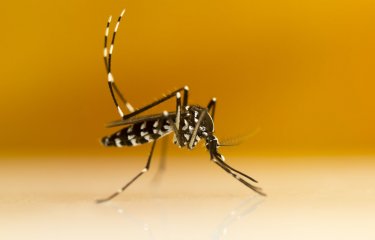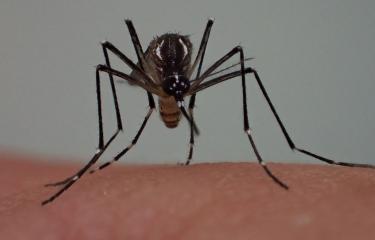From the tiger mosquito, now well established in Europe, to endemic species in the tropics or Pacific region, these insects have colonized vast areas of the planet and play a key role in local ecosystems. Only around a hundred mosquito species, some of which potentially transmit pathogenic agents, are known to bite humans. Given their diversity and geographic expansion, special efforts must be made to identify these insects and map their distribution.
Of the multiple mosquito species encountered globally, some act as vectors transmitting infectious diseases to humans throughout the world. Almost 3,500 mosquito species have been described in total, 65 of which have been observed in mainland France. Of these 3,500 species, only around a hundred are known to bite humans.
It has been established that mosquitoes' (or vectors') ability or inability to transmit specific arboviruses is linked to their species. This even applies in instances where several species share the same environment. Scientists describe this phenomenon as "vector competence" to transmit a given virus, or vector specificity. The mechanisms of why only certain mosquitoes are able to transmit specific arboviruses as vectors remain poorly understood. However, we do know that this specificity is regulated by the molecular affinity between mosquito and virus. Ecological and behavioral factors also come into play, either as barriers or factors facilitating disease transmission.
Below are some examples of recent studies on "vector competence" or the ability of certain mosquitoes to transmit certain viruses:
- The tiger mosquito can transmit the chikungunya virus in temperate conditions
- Tiger mosquito: two viruses newly transmitted from birds to humans (in French)
- Chikungunya: how the tiger mosquito helps the virus cross borders
- Yellow fever: risk of virus transmission in the Asia-Pacific region
- Chikungunya: the specific interactions between the genotypes of mosquitoes and viruses have influenced Ae. albopictus vector competence for the virus
- In France, Aedes albopictus better transmits the African "Zika" than the Asian one
Aedes mosquitoes and emerging viral diseases with serious health implications
Mosquitoes of the genus Aedes are major vectors: Aedes aegypti (the Egyptian or yellow fever mosquito) transmits dengue, Zika virus and chikungunya, mainly in tropical and subtropical regions of America, Africa, Asia and the Pacific, as well as yellow fever in South America and Africa. Aedes albopictus (the tiger mosquito), another species from the same genus native to Asia, has extensively colonized Europe, the Americas, Africa and the Indian Ocean, contributing to the spread of dengue, chikungunya, Zika virus and filariasis. Its competence to transmit the yellow fever virus has even been proven.
In the Pacific islands, particularly French Polynesia, Aedes polynesiensis causes the transmission of Zika virus, dengue and chikungunya, as well as lymphatic filariasis, which can lead to severe complications including lymphedema.
The Anopheles mosquito chiefly responsible for transmitting malaria
Malaria is a major parasitic disease transmitted by mosquitoes of the genus Anopheles. They include Anopheles gambiae, Anopheles funestus and Anopheles stephensi (collectively referred to as Anopheles mosquitoes), which are mainly responsible for the transmission of malaria and filariasis in Africa, tropical parts of Asia and Latin America.
Culex: a widely distributed genus
Finally, mosquitoes of the genus Culex, including Culex quinquefasciatus and Culex pipiens, often referred to as typical mosquitoes, can be found on almost all continents. They contribute to the spread of West Nile virus, Japanese encephalitis, lymphatic filariasis, Usutu virus and St. Louis encephalitis, affecting Europe, Africa, the Americas and Asia.
Below is a summary of the main mosquito species that are vectors for infectious diseases, showing the diseases transmitted and geographic regions inhabited:
| Species | Aedes aegypti | Aedes albopictus | Aedes polynesiensis | Anopheles spp. | Culex spp. |
| Commun name |
Yellow fever mosquito |
Tiger mosquito | / |
Anopheles mosquito |
Typical mosquito |
| Diseases transmitted |
Dengue, Zika, chikungunya, yellow fever |
Dengue, Chikungunya, Zika |
Elephantiasis (lymphatic filariasis), Zika, dengue, chikungunya |
Malaria, filariasis (some species) | West Nile virus, Japanese encephalitis, lymphatic filariasis, Usutu virus, St. Louis encephalitis |
| Regions | Tropical and subtropical regions of America, Africa, Asia and the Pacific. |
Originally Asia |
Oceania, particularly French Polynesia and the South Pacific islands. |
Africa, tropical Asia, Latin America. |
Worldwide |
Click on the link below to access maps showing mosquito species distribution and diseases observed in specific regions:
Frontiers | Vector Specificity of Arbovirus Transmission
Mosquitoes are highly adaptable insects, with prime examples including Anopheles mosquitoes in malarial regions, tiger mosquitoes in regions affected by dengue and chikungunya, and typical mosquitoes in West Nile virus foci, proving the need for continuous international surveillance, given the wide range of vector-borne diseases encountered. This is all the more pressing given the current context of climate change and population movement between continents.





